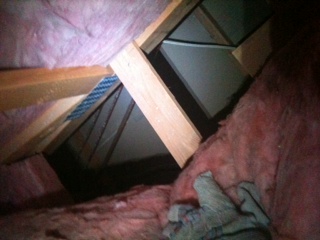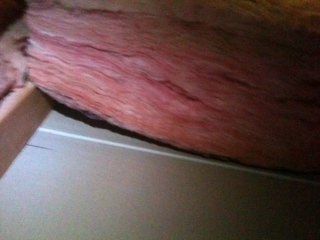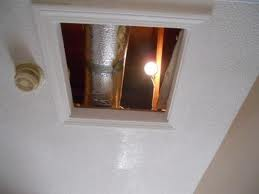 Attic insulation is extremely important for energy savings. If you have ever gone into your attic, you may not even know what you are looking for. With insulation, it is the R-value that people look for. Certainly R-value is important, but so is the way the insulation is installed.
Attic insulation is extremely important for energy savings. If you have ever gone into your attic, you may not even know what you are looking for. With insulation, it is the R-value that people look for. Certainly R-value is important, but so is the way the insulation is installed.
If you have fiberglass batts installed, most people will look for a printed R-value. If they see R-30, then they think all is well. Not so. If your insulation is compressed or worse, not even contacting the drywall ceiling below, your R-value could be virtually zero.
Take a look at the picture. If you were just to pop your head up in the attic and look around, you would see a beautiful sea of fiberglass batt insulation, seemingly doing its job to perfection. Under all that insulation lies a nasty secret: areas of that insulation aren’t doing a darn thing.
The picture shows me lifting up a batt to check out what is underneath it, and as it turns out, there is about a 4 foot drop to the ceiling below. You can see some pipes running across the uninsulated ceiling. This dropped ceiling is over a front entryway and a chandelier hangs from it. This entire area has no insulation and is approximately 6’x 12’. This large area will effectively lower the R-value of the entire ceiling.
 I’ve been doing some insulation work and the quality of other people’s work is amazing. I don’t know if the previous worker just didn’t know how to install fiberglass batt insulation or if he was just lazy and wanted to move to the next job.
I’ve been doing some insulation work and the quality of other people’s work is amazing. I don’t know if the previous worker just didn’t know how to install fiberglass batt insulation or if he was just lazy and wanted to move to the next job.
In order for insulation to reach its full advertised R value, it must be installed correctly. Actually, it must be installed perfectly. The batt must not be compressed, rounded, or laying on top of things like cables or pipes. It must be in direct and full contact with the drywall ceiling below it.
I went through an attic and concentrated on a vaulted ceiling. This room was the warmest in the house in summer, and coldest in the winter. And for good reason. The batt insulation was hardly even touching the drywall. In fact, the batts were just sitting on top of the ceiling joists with just the center touching the drywall ceiling. This is rounding and the picture above shows this condition. The full face of the batt needs to be squarely installed so that it sits nicely in the middle of the joists. With the rounding I saw, although the batt had an R value of 30 printed right on it, it probably was performing at around an R-4 or so.
 You probably don’t have any insulation on your attic access panel. If you are like most homeowners, you will simply have a piece of drywall cut to fit into a hole and held there by resting on a lip from some molding.
You probably don’t have any insulation on your attic access panel. If you are like most homeowners, you will simply have a piece of drywall cut to fit into a hole and held there by resting on a lip from some molding.
If you have R-30 in your attic but have no insulation at your attic panel, you are lowering the R-value for the entire attic.
You will need a few parts for this but it won’t break the bank. I would get a 1”x3” strip and cut it to fit around the perimeter of the scuttle hole. You can paint it to match the ceiling. Secure it to the bottom perimeter of the opening so that it sits on top of the lip of the molding (where the attic panel used to sit. You can caulk it and paint it and make it pretty if you choose.
For the insulation, you can use poly-iso (poly-isocyanurate) or polystyrene rigid board. These are rigid foam boards that you can cut to fit. You can cut the board with a utility knife. You could use the attic panel as a template and cut them to fit, or you can just measure and cut the pieces from your measurements. You will need several layers of the boards to get a good R-value. Poly-iso has an R-value of 7 per inch while polystyrene is 4-5 per inch, depending upon whether it is extruded or expanded. You can build up the back of the panel with several layers of the insulation board. Use the appropriate adhesive for these boards, as some adhesives will degrade the boards
Finally, lay a strip of weather stripping along the top of the ledger board you previously installed at the perimeter of the attic scuttle hole. You will lastly want to fashion a way to hold the panel down with enough tension that air won’t leak. You can do this with an eyehook, or even a latch. You can get as creative as you want, but the point is to compress the weather stripping to stop any air leaks.
 Attic Insulation is crucial for energy conservation. The higher the R-value of your attic insulation, the greater the insulating effectiveness. The R-value is a measure of insulation’s resistance to heat flow.
Attic Insulation is crucial for energy conservation. The higher the R-value of your attic insulation, the greater the insulating effectiveness. The R-value is a measure of insulation’s resistance to heat flow.
Determining your attic’s r-value is a matter of determining what type of insulation you have, how thick the insulation is, and how well it was installed. Also, the overall r-value of your attic may not be the same as the insulation in it, because heat flows around the insulation and through studs and joists. An infrared camera illustrates this very well.
Here are some common do-it-yourself materials used for attics and their R-values:
Insulation Type R-Value per inch
Blown Cellulose 3.7
Blown Fiberglass 2.8
Fiberglass batts 3.0*
*The quality of the installation is extremely important with insulation. Fiberglass batts have to be correctly installed for this R-value. If they are compressed, or if there are gaps the r-value drops substantially.
You can measure the depth of the insulation and multiply this by the r-value. The effective r-value takes into consideration how well it was installed. There are formulas to determine the degree to which these values drop, but the message is that installing batts is at least as important as the insulation itself.
 It may not be tonight, but it's coming. That time of year when we get a short period of freezing temperatures. Its good for business but a real headache for homeowners. Which brings me to the topic of today's post. Insulate your exposed exterior piping. The most common occurrence in a freeze is that the piping and/or pressure vacuum breaker (or anti-siphon valve) freezes and splits open. The piping is typically PVC and the pressure vacuum breaker (PVB) is brass. As water freezes it expands...and the strength of this is phenomenal. Freezing water will easily split brass or copper piping. You have to try to keep them warm.
It may not be tonight, but it's coming. That time of year when we get a short period of freezing temperatures. Its good for business but a real headache for homeowners. Which brings me to the topic of today's post. Insulate your exposed exterior piping. The most common occurrence in a freeze is that the piping and/or pressure vacuum breaker (or anti-siphon valve) freezes and splits open. The piping is typically PVC and the pressure vacuum breaker (PVB) is brass. As water freezes it expands...and the strength of this is phenomenal. Freezing water will easily split brass or copper piping. You have to try to keep them warm.
Manufacturers make heat tape which is plugged into an electrical outlet that warms up and protects the piping. With heat tape though you can't wrap it on itself, it can only make contact with the pipe.
In my climate, I use typical pipe insulation to protect the pipes and the pressure vacuum breaker. You can open the insulation up and cover various areas on the PVB and then tape everything together.
You can also buy covers that are made of a Styrofoam material and then place this directly over the PVB assembly.
In a pinch, you can drape the entire assembly with a towel and then cover that with a plastic garbage bag. The towel will help keep the cold off of the assembly and the plastic garbage bag will keep it dry (and prevent it from freezing) if it rains. This makes for cheap but effective anti-siphon valve insulation.